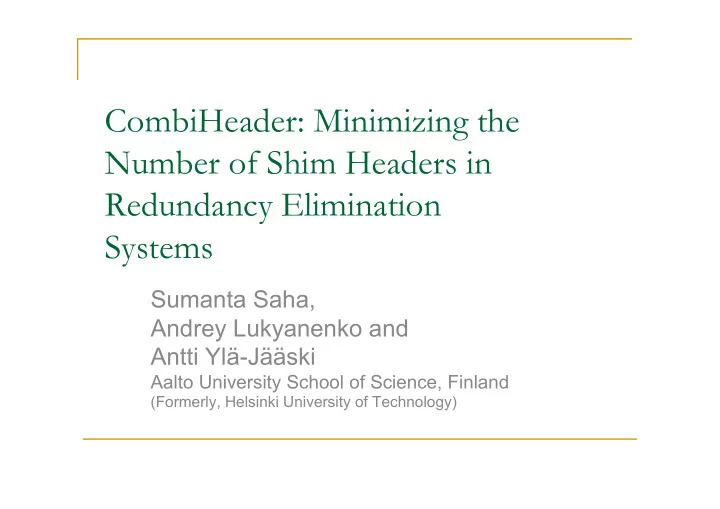

CombiHeader: Minimizing the Number of Shim Headers in Redundancy Elimination Systems Sumanta Saha, Andrey Lukyanenko and Antti Ylä-Jääski Aalto University School of Science, Finland (Formerly, Helsinki University of Technology)
Outline Redundancy elimination systems Finer vs. coarser chunk size CombiHeader algorithm Proof-of-Concept implementation Evaluation Summary 15.Apr.2011 2 Sumanta Saha
Redundancy Elimination Systems Redundancy Elimination (RE) systems work on packet payload level Chunks the payload using Rabin Fingerprinting Content based Application independent The idea is complementary to traditional caching Aims to remove redundant content from upstream nodes to downstream Eliminates duplicate traffic when traditional caching fails 15.Apr.2011 3 Sumanta Saha
Redundancy Elimination Systems Chunk Store R1 1 2 2 R2 R n 2 15.Apr.2011 4 Sumanta Saha
Finer vs. Coarser Chunk Sizes With coarser chunk size there is always a possibility of missing possible matching regions Finer chunk sizes have more protocol overhead The proposed algorithm, CombiHeader, uses an adaptive method to dynamically choose the best chunk size Please refer to the paper for a mathematical interpretation 15.Apr.2011 5 Sumanta Saha
CombiHeader We need a dynamic system to adapt to the content type, and chunk popularity to get the best out of it CombiHeader works on chunk popularity to generate bigger chunks out of smaller ones Optimized to deliver least memory access while matching to the largest chunk possible 15.Apr.2011 6 Sumanta Saha
CombiHeader Chunk Trail: H1 H2 H3 H4 H1 H2 H3 H1 H2 H3 H1H2H3 1 H1H2 H2H3 1 2 1 1 1 2 1 3 3 2 1 1 H1 H2 H3 H4 1 1 15.Apr.2011 7 Sumanta Saha
CombiHeader Inser&on ¡of ¡CombiHeaders ¡to ¡the ¡outgoing ¡stream ¡ Trail: h1h2h3h4h1h2h3h1h2h3h5 Last elementary: h1 h2 h3 h4 h1 h2 h3 h1 h2 h3 h5 Last CombiNode : - - - - - h1h2 - - h1h2 h1h2h3 - Cache hit/miss : M M M M H H H H H H M Insert in trans: F(h1) F(h2) F(h3) F(h4) - - h1h2 h3 - - h1h2h3 & F(h5) F(h x ) = Full payload for chunk x h x = Elementary header for chunk x h x h y = CombiHeader for combined chunks x and y 15.Apr.2011 8 Sumanta Saha
Proof-of-Concept Implementation done in pure C Chunking engine CombiHeader plug-in Rabin fingerprinting for RE SHA-1 hashing for fingerprinting Chunking can be done in both IP and TCP layer Experiments were done on TCP layer Directed graph to keep track of all the CombiHeaders generated A threshold parameter θ is used to control the CombiHeader generation process 15.Apr.2011 9 Sumanta Saha
Evaluation Effect of CombiHeader over CombiHeader allowing smaller header transmission chunk size with the same benefit as larger ones X-axis represents initial preliminary chunk size Traffic comprises of video files with intermittent similarity 15.Apr.2011 10 Sumanta Saha
Evaluation Running CombiHeader on real Effect of CombiHeader over world HTTP traces total bytes transmitted to wire X-axis represents the number of files transferred through the router 15.Apr.2011 11 Sumanta Saha
Summary CombiHeader addresses the question of what should be the optimal chunk size for a particular traffic Depending on the dynamic nature of the user traffic and the underlying similarity, CombiHeader adapts itself to deliver the best possible chunk size Helps to reduce protocol overhead to the wire Possible deployment challenges: Cache synchronization among routers Routing decision making 15.Apr.2011 12 Sumanta Saha
Recommend
More recommend